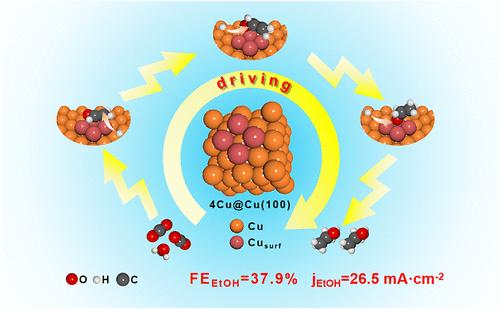当前位置:
X-MOL 学术
›
ACS Appl. Mater. Interfaces
›
论文详情
Our official English website, www.x-mol.net, welcomes your feedback! (Note: you will need to create a separate account there.)
Critical Role of Cu Nanoparticle-Loaded Cu(100) Surface Structures on Structured Copper-Based Catalysts in Boosting Ethanol Generation in CO2 Electroreduction
ACS Applied Materials & Interfaces ( IF 8.3 ) Pub Date : 2024-06-29 , DOI: 10.1021/acsami.4c05973 Zhijian Chen 1 , Zhenghui Ma 1 , Guoli Fan 1 , Feng Li 1
ACS Applied Materials & Interfaces ( IF 8.3 ) Pub Date : 2024-06-29 , DOI: 10.1021/acsami.4c05973 Zhijian Chen 1 , Zhenghui Ma 1 , Guoli Fan 1 , Feng Li 1
Affiliation

|
Presently, realizing high ethanol selectivity in CO2 electroreduction remains challenging due to difficult C–C coupling and fierce product competition. In this work, we report an innovative approach for improving the efficiency of Cu-based electrocatalysts in ethanol generation from electrocatalytic CO2 reduction using a crystal plane modification strategy. These novel Cu-based electrocatalysts were fabricated by electrochemically activating three-dimensional (3D) flower-like CuO micro/nanostructures grown in situ on copper foils and modifying with surfactants. It was demonstrated that the fabricated Cu-based electrocatalyst featured a predominantly exposed Cu(100) surface loaded with high-density Cu nanoparticles (NPs). The optimal Cu-based electrocatalyst displayed considerably improved CO2 electroreduction performance, with a Faraday efficiency of 37.9% for ethanol and a maximum Faraday efficiency of 68.0% for C2+ products at −1.4 V vs RHE in an H-cell, accompanied by a high current density of 69.9 mA·cm–2, much better than the particulate Cu-based electrocatalyst. It was unveiled that the Cu(100)-rich surface of nanoscale petals with abundant under-coordinated copper atoms from CuNPs was conducive to the formation and stabilization of key *CH3CHO and *OC2H5 intermediates, thereby promoting ethanol generation. This study highlighted the critical role of CuNP-loaded Cu(100) surface structures on structured Cu-based electrocatalysts in enhancing ethanol production for the CO2 electroreduction process.
中文翻译:

结构化铜基催化剂上负载 Cu 纳米颗粒的 Cu(100) 表面结构在促进 CO2 电还原中乙醇生成中的关键作用
目前,由于C-C耦合困难和产品竞争激烈,在CO 2 电还原中实现高乙醇选择性仍然具有挑战性。在这项工作中,我们报告了一种创新方法,使用晶面修饰策略提高电催化 CO 2 还原生产乙醇中铜基电催化剂的效率。这些新型铜基电催化剂是通过电化学激活在铜箔上原位生长的三维(3D)花状 CuO 微/纳米结构并用表面活性剂进行改性而制成的。结果表明,所制造的铜基电催化剂具有主要暴露的 Cu(100) 表面,负载有高密度铜纳米颗粒 (NP)。最佳的铜基电催化剂表现出显着改善的 CO 2 电还原性能,在 -1.4 时乙醇的法拉第效率为 37.9%,C 2+ 产物的最大法拉第效率为 68.0% H 电池中的 V vs RHE,伴随着 69.9 mA·cm –2 的高电流密度,比颗粒状铜基电催化剂好得多。结果表明,纳米花瓣表面富含 Cu(100),且具有丰富的 CuNPs 欠配位铜原子,有利于关键 *CH 3 CHO 和 *OC 2 中间体,从而促进乙醇生成。这项研究强调了结构化铜基电催化剂上负载 CuNP 的 Cu(100) 表面结构在提高 CO 2 电还原过程中乙醇产量方面的关键作用。
更新日期:2024-06-29
中文翻译:

结构化铜基催化剂上负载 Cu 纳米颗粒的 Cu(100) 表面结构在促进 CO2 电还原中乙醇生成中的关键作用
目前,由于C-C耦合困难和产品竞争激烈,在CO 2 电还原中实现高乙醇选择性仍然具有挑战性。在这项工作中,我们报告了一种创新方法,使用晶面修饰策略提高电催化 CO 2 还原生产乙醇中铜基电催化剂的效率。这些新型铜基电催化剂是通过电化学激活在铜箔上原位生长的三维(3D)花状 CuO 微/纳米结构并用表面活性剂进行改性而制成的。结果表明,所制造的铜基电催化剂具有主要暴露的 Cu(100) 表面,负载有高密度铜纳米颗粒 (NP)。最佳的铜基电催化剂表现出显着改善的 CO 2 电还原性能,在 -1.4 时乙醇的法拉第效率为 37.9%,C 2+ 产物的最大法拉第效率为 68.0% H 电池中的 V vs RHE,伴随着 69.9 mA·cm –2 的高电流密度,比颗粒状铜基电催化剂好得多。结果表明,纳米花瓣表面富含 Cu(100),且具有丰富的 CuNPs 欠配位铜原子,有利于关键 *CH 3 CHO 和 *OC 2 中间体,从而促进乙醇生成。这项研究强调了结构化铜基电催化剂上负载 CuNP 的 Cu(100) 表面结构在提高 CO 2 电还原过程中乙醇产量方面的关键作用。











































 京公网安备 11010802027423号
京公网安备 11010802027423号